Biden’s Cancer ‘Moonshot’ Can’t Escape Drug Price Controls’ Gravity
Last week, President Joe Biden announced the re-launch of his "Cancer Moonshot" initiative, a project he created in 2016 while serving as Vice President in the Obama administration. The ambitious effort aims to "end cancer as we know it today" by, among other things, halving the death rate from the disease by 2047. That goal is laudable. It will also be impossible to achieve if the president continues to make prescription drug price controls a top administration priority. The only way to spur the...



